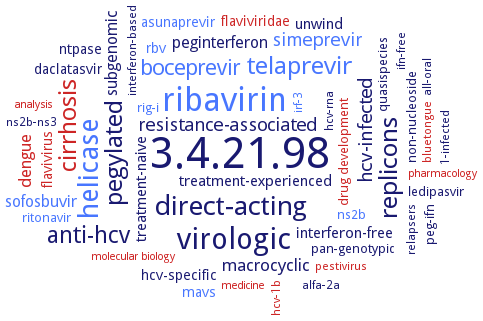3.4.21.98: hepacivirin
This is an abbreviated version!
For detailed information about hepacivirin, go to the full flat file.

Word Map on EC 3.4.21.98 
-
3.4.21.98
-
ribavirin
-
virologic
-
helicase
-
direct-acting
-
replicons
-
telaprevir
-
cirrhosis
-
pegylated
-
anti-hcv
-
boceprevir
-
hcv-infected
-
resistance-associated
-
simeprevir
-
macrocyclic
-
dengue
-
peginterferon
-
sofosbuvir
-
subgenomic
-
unwind
-
treatment-naive
-
treatment-experienced
-
interferon-free
-
flaviviridae
-
mavs
-
flavivirus
-
hcv-specific
-
rbv
-
daclatasvir
-
asunaprevir
-
ntpase
-
peg-ifn
-
pan-genotypic
-
rig-i
-
non-nucleoside
-
ledipasvir
-
ns2b
-
quasispecies
-
ritonavir
-
drug development
-
1-infected
-
bluetongue
-
alfa-2a
-
ifn-free
-
relapsers
-
interferon-based
-
pestivirus
-
hcv-rna
-
ns2b-ns3
-
all-oral
-
irf-3
-
hcv-1b
-
molecular biology
-
analysis
-
pharmacology
-
medicine
- 3.4.21.98
- ribavirin
-
virologic
- helicase
-
direct-acting
-
replicons
- telaprevir
- cirrhosis
-
pegylated
-
anti-hcv
- boceprevir
-
hcv-infected
-
resistance-associated
- simeprevir
-
macrocyclic
- dengue
-
peginterferon
- sofosbuvir
-
subgenomic
-
unwind
-
treatment-naive
-
treatment-experienced
-
interferon-free
- flaviviridae
- mavs
- flavivirus
-
hcv-specific
- rbv
-
daclatasvir
- asunaprevir
- ntpase
-
peg-ifn
-
pan-genotypic
- rig-i
-
non-nucleoside
-
ledipasvir
- ns2b
-
quasispecies
- ritonavir
- drug development
-
1-infected
- bluetongue
-
alfa-2a
-
ifn-free
-
relapsers
-
interferon-based
- pestivirus
-
hcv-rna
-
ns2b-ns3
-
all-oral
- irf-3
- hcv-1b
- molecular biology
- analysis
- pharmacology
- medicine
Reaction
Hydrolysis of four peptide bonds in the viral precursor polyprotein, commonly with Asp or Glu in the P6 position, Cys or Thr in P1 and Ser or Ala in P1' =
Synonyms
Cpro-2, Cpro-2 proteinase, Den2 protease, HCV NS3, HCV NS3 protease, HCV NS3/4A, HCV NS3/4A protease, Hepacivirin, hepatitis C virus NS3 serine protease, hepatitis C virus NS3/4A protease, non-structural 3 protein, nonstructural 3 protease, nonstructural protein 3, nonstructural protein 3-4A serine protease, nonstructural protein 3-4Agene, nonstructural protein 3/4A protease, NS2/3 protease, NS2B-NS3 proteinase, NS2B/NS3 protease, NS3, NS3 protease, NS3 protein, NS3 proteinase, NS3 serine protease, NS3 serine proteinase, NS3-4A, NS3-4A protease, NS3-4A serine protease, NS3-4A serine protease complex, NS3-4A serine proteinase, NS3-NS4A protease, NS3-protease, NS3-SP, NS3/4a, NS3/4A protease, NS3/4A protease complex, NS3/4A serine protease, NS34Agene, NS3?4A, NS5A-5B protease, P70, polyprotein-processing proteinase NS3, proteinase NS3, proteinase, polyprotein-processing, NS3, sc-protease, serine protease NS3, serine proteinase NS3


 results (
results ( results (
results ( top
top





